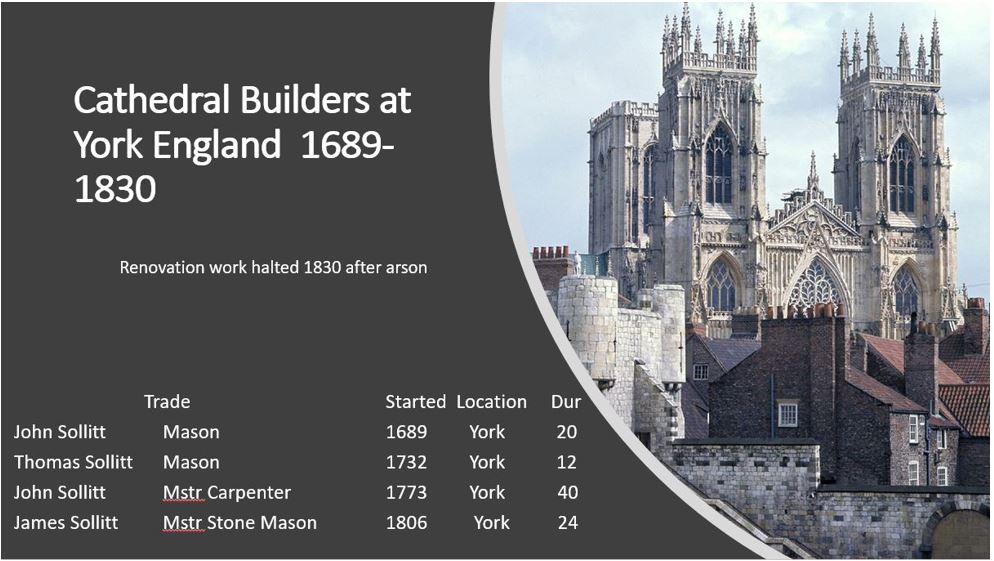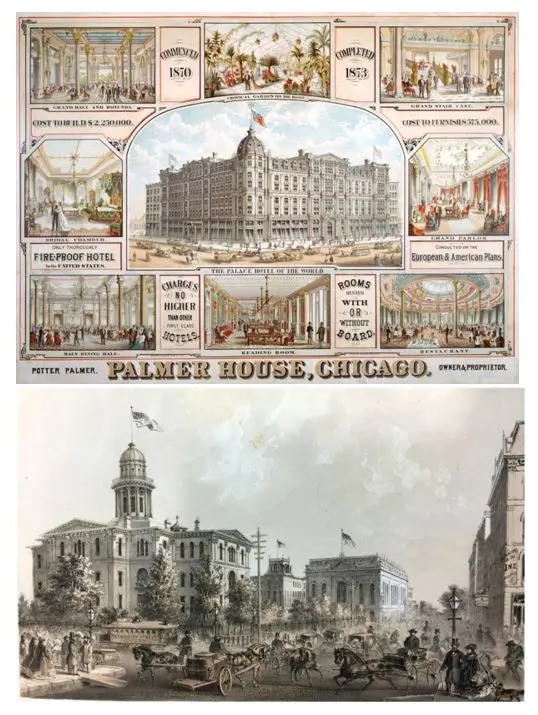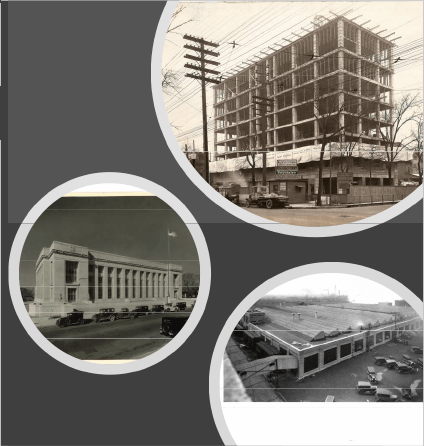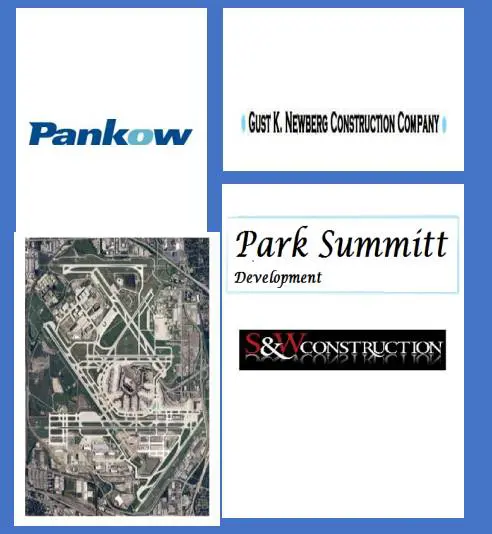Sollitt: A Family Company Since 1838

Sollitt 1650
The story of one family that worked as both construction workers and company owners through eight generations since 1650


1689 - 1830 Cathedral Builders at York England
- The Sollitt family came to England from France as experienced Cathedral and fortification builders after the revocation of the Edict of Nantes by Louis the XIV making it impossible for Protestants to continue to be cathedral builders
- The York Minister Cathedral needed repairs due to damage from the religious wars, and the Sollitt’s found steady work there for over 100 years. This project came to an end in its last stages of its repairs due to arson, and with no money to rebuild it James Sollitt and his three boys – John, Thomas and William were out of jobs.


1830's John Sollitt Comes to North America
John Sollitt moved his wife and son to North America after the York Minster Cathedral fire. First settling in Hamilton, Canada for a year and then they moved to Chicago. John found work was plentiful and sent for his two brother to come and help him.


1830 - 1850 William & Thomas Sollitt Move & The Brothers Begin Building
- 1836 Thomas came to Chicago
- 1838 William came to Chicago and the brothers began building and worked for Azel Peck until 1840
- 1840 - 1845 Updike, Peck & Sollitt
- 1846 - 1850 Updike & Sollitt
- 1849 William got gold fever and went to California for 7 years


1851 - 1870 Sollitt & Son's Becomes Builder of Choice in Chicago
- John and Thomas had started Sollitt & Son's
- In 1856 William returned to Chicago from California and started his own Sollitt Construction Company in 1857; there were now two Sollitt construction companies
- By the end of the Civil War Sollitt & Sons was one of the largest builders in Chicago. Among others they built the first Palmer House and first City County Building.


1871 Sollitt Brothers Begin Reconstruction of Chicago
- October 8, 1871 the Chicago Fire left 100,000 people homeless after burning 3.3 square miles and 68% of structures. John Sollitt's office and yard were destroyed by the fire, but William Sollitt's construction yard was saved.
- The three Sollitt brothers joined forces again and began to rebuild the city for their clients.


1875 The Next Generation of Sollitt Boys
- The Sollitt brothers gave the company to the next generation, Thomas' sons Ralph, Thomas and Sumner who reinvented it as Sollitt Brothers Construction.
- 20 years after the fire, Chicago had rebuilt and celebrated with the Chicago World's Fair. Both Machinery hall and Transportation Building were two of many buildings built by Sollitt Brothers Construction.


Ralph's Concrete Mixing Machine
- On April 7th, 1908, Ralph T. Sollitt obtained a patent for his concrete mixing machine. Ralph's invention mixed the ingredients used in making concrete. Ralph's machine was able to ensure materials both before and after mixing were more economically and easily handled.
- Fig. 1 shows a side elevation, showing one form of the machine embodying Ralph's invention.
- Fig. 17 is a side elevation of a further modification, illustrating the application of Ralph's improvements to a self-moving or automobile machine.


1913 Sollitt Brothers Construction Splits
- Ralph & Sumner Sollitt split Sollitt Brothers Construction into two companies as they believed this was the best way to keep the company growing while also training their sons to run the company.
- All three brothers sent their oldest children to Engineering School.
- The company was split into Ralph Sollitt & Sons Construction Company and Sumner Sollitt & Sons Construction Company.
- Both became major companies known throughout the country.


WWI Finds Sollitt as Vibrant Leaders
- The Sollitt's found themselves as leaders in construction of fireproof buildings and manufacturing plants here at Fort Sheridan
- Ralph Shannon Sollitt was sent to France as a Captain in the Corp or Engineers. The remaining Sollitt's who did not go to war were left to run the business and built some of the major military facilities in the Midwest. Their record was building 86 building in 9 days
- As the war ended and the roaring twenties kicked off Ralph Sollitt was getting lots of orders for work in areas away from Chicago. He sent his son Ralph Shannon to South Bend, IN to start a branch company and kept his son George to focus on their existing clients.


1927 Sumner Sollitt named AGC President
Sumner Sollitt was very active in the AGC and eventually became its national president.


University of Notre Dame
In South Bend Ralph Shannon was able to survive as Sollitt found a new client, The University of Notre Dame. Sollitt was able to build a relationship that became depression proof as Notre Dame's football money allowed the University and Sollitt to build while almost no one else was. The continued expansion of 1 to 2 buildings a year at Notre Dame allowed Sollitt to go after other WPA work in Southern States and build a specialty in electric power generation.


1933 Ralph Sollitt & Sons Construction Splits
Ralph Sollitt & Sons Construction split again in 1933. Ralph Sollitt retired in 1933 and split his company between his 3 boys, Ralph, George and Lincoln. George Sollitt kept all the clients in Chicago and Ralph Shannon Sollitt got building rights for the rest of the country and Notre Dame.




Sollitt Goes to War Again
- All 3 Sollitt construction companies were in good financial shape, and in much better financial shape than their competition. They were poised to serve the industrial needs of the war efforts of WWII.
- Sumner Sollitt was able to build military training facilities in the Great Lakes Naval Station.
- George Sollitt worked on improving transportation networks and airfields.
- Ralph Shannon Sollitt in South Bend was even better positioned as a heavy industrial contractor working on munitions plants, power generation plants and steel smelting facilities.




Prosperity for Sollitt Construction Companies Post WWII
All three companies continued to prosper after the war.


George Sollitt Construction Expansion Post War
George Solllitt Construction continued in Chicago building mostly institutional buildings, corporate headquarters and healthcare.


Sumner Sollitt Construction Expansion Post War
- Sumner Sollitt Construction in Chicago was taken over by Sumner Sollitt Jr. and continued with building developer led projects like the Mies Van Der Rohe skyscraper apartment complex on Lake Shore Drive.
- Sumner Jr. also entered new construction international markets with projects consisting of dams and highways in Puerto Rico.
- He also became a builder of high-end churches for many different denominations.



Sollitt Construction Company Expansion Post War
- In South Bend, Ralph S. Sollitt and Sollitt Construction Company was by far the largest of the 3 companies having a 1951 ENR Ranking #5. Ralph continued to build in the power generating industry and built the largest dam east of the Mississippi in Virginia.
- He found other industrial clients in automotive, aerospace, steel and food processing.
- Sollitt began to build nuclear power projects which came to an abrupt halt following the Three Mile Island incident, which he sought to replace this loss with healthcare projects.



1967 A New Generation of Sollitt Family Expands into New Markets
- In 1967 Ralph S., George and Sumner Jr. Sollitt had succession plans in place for their heirs to replace them so they could retire. At this time, the new generation, with approval of the older generation, were actively looking for new geographical and product type expansion opportunities.
- They moved into Florida, California and even went back to building for the World's Fair.


"People are what made Sollitt Construction a great company" - Ralph Sollitt 1978
Many people who worked for the Sollitt Construction Companies worked there for their entire lives. Maurie Bontrager started working for Sollitt Construction in 1929 on Notre Dame Stadium and continued to work until he retired in 1986.


Legacy Companies
All along the lifecycle of Sollitt companies, employees would leave and often start new companies. These Sollitt legacy companies often became much larger than the Sollitt companies themselves. Two of the most successful being Pankow Construction and Gust K. Newberry Construction Company.


Profit Sharing to ESOP
The George Sollitt Construction Company became and ESOP November 30, 1976, after having been a profit-sharing company since December of 1969.


1980's Succession Plans and Economic Downturns End Two of Three Sollitt Companies
- As the economic downturn of 1980 hit the 3 Sollitt companies, each had its own theory on how to survive.
- George Sollitt formed an ESOP and sold the company to the employees
- Sumner Sollitt Jr. laid off all his employees and tried to wait out the downturn but eventually had to close the business in 1984
- South Bend Sollitt Construction tired to diversify the company while divesting its assets, selling its ready-mix concrete company, its subsidiary construction companies and eventually its own building, only to find that surety credit became hard to obtain and consequently closes its doors in 1986.


George Sollitt Construction Company #42 ENR Top Midwest
Today, only the George Sollitt Construction Company remains a viable business enterprise.


Today George Sollitt Construction Company is 100% Employee-Owned
The Sollitt tradition continues with the 100% employee-owned George Sollitt Construction Company. It is thriving in a strong construction market in Chicago having weathered four separate recessions and completely new corporate leadership. Recent Presidents have been John Pridmore Sr., Don Maziarka, Howard Strong, John Pridmore Jr., James Zielinski, and currently Henry Ryan.

